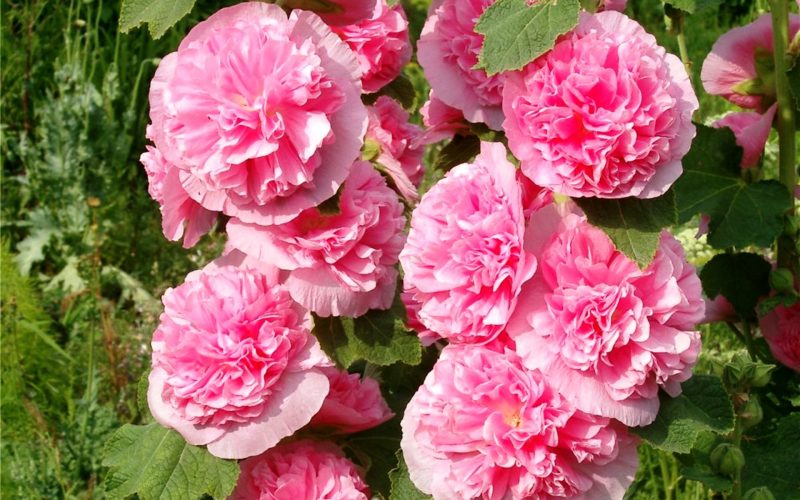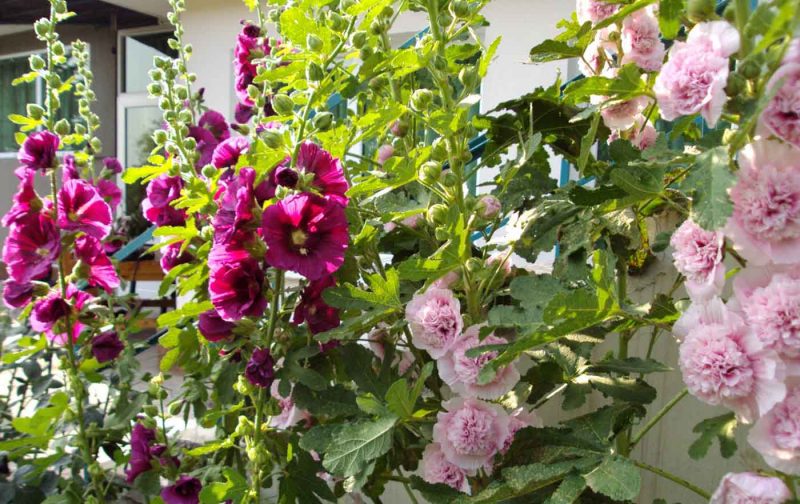The stock is rose, mallow, pink marshmallow, mallow ... As soon as this flower is not called. But still, these plants differ from each other. The stock-rose, popular until the middle of the last century, today has somewhat lost its fans, but now new varieties of this culture have been developed, designed to restore gardeners' interest in this amazing beauty. They have a brighter color and larger flowers, and the unpretentiousness and variety of plant shapes can decorate the flower garden and add a touch of old Russian front gardens to it.
Material Content:
Description, types and medicinal properties of the plant
Plant height from 50 cm to 2 m. The trunk is hard. Carved leaves are deep green. They are located from the bottom to the middle of the stem. Flowers are located on the stem. Their size is from 7 to 15 cm. A variety of colors - all the colors of the rainbow.
After flowering, seed bolls are formed. They ripen seeds - flat semicircular. They have notches, thanks to which the seeds are easily carried at a distance, clinging to animals, plants, clothes. Germination is maintained up to 5 years.
There are various types of this flower.
- A wrinkled rose has simple yellow inflorescences. An unpretentious plant, propagated by seeds that have fallen to the ground.
- The stem rose of Pleniflora Chaters is decorated with double flowers, white, pink or yellow. Violet shades are found. This is a biennial plant. It is better to propagate seedlings, blooms in the second year.
- The Royal Rose. It is grown as annual seedlings. It has a height of 50 cm and terry flowers of different colors. It blooms from July to September. Suitable for cutting.
- Varieties Polarstern and Mars Magic bloom in simple colors of yellow, pink and dark red.
- Hybrids of pink stock-rose and marshmallow officinalis. It has simple flowers of various colors. Perennial grade. They do not form seeds, propagate by cuttings or by dividing the bush.
This plant is a medicinal and is used in traditional medicine. Decoctions are used to rinse with sore throat, dental diseases, tinctures treat cough. The gruel from the crushed parts of the plant is used to moisturize the skin.
Rose stock or Mallow?
The stem rose has the Latin name Alcea rosea. This is the most famous member of the Malvaceae family. In common parlance - mallow, although this is not entirely correct. What is the difference between mallow and stock roses? The concept of mallow covers a wider range of plants and has such subspecies as wild and musky mallow, medicinal marshmallow and others.
Still, it is correct to call the plant under discussion a stem rose.
Cultivation and care
Caring for a flower begins with choosing a place of growth. He loves sunny areas. The soil requires light, fertile, well-drained soil. To ensure stability to the tall plant and prevent it from bending from the wind, it is planted against a wall or fence.
Growing from seeds is a common way of stem rose propagation. Ripened seeds fall into the soil and germinate easily. After a year, the plant begins to bloom.
Tip. To keep your blooming rose constantly, ensure that the seeds hit the soil every year. On the bed should be a plant of the second year of life.
To get an early flowering of a rose, it is grown through seedlings:
- Seeds are planted at the end of February.
- Before this, they are soaked for 15 to 24 hours in a wet towel.
- Prepare fertile soil with drainage.
- Seeds are placed through 4 - 5 cm and buried by 2 cm.
- The soil is watered and covered with a transparent film or glass.
- Tanks are installed in a warm, bright place.
After the appearance of 4 leaves, the seedlings are transplanted into separate deep cups. The root of the stem rose is long and grows rapidly. In the early days of May, seedlings are already planted in flower beds. They will please flowering in early July. Large plants are placed at a distance of 50 cm from each other.
The usual varieties of stock roses are quite unpretentious. She can grow in the garden without any care. If the land was once fertilized, then this will be enough.
In a dry spring, flowerbeds are watered to provide seedlings of young plants. Weeds are removed, the soil is slightly loosened, you can sprinkle a little dry fertilizer of urea. If there is little rain in the summer, the stock rose should be watered.
Hybrid varieties of stock roses require other care:
- These plants bloom for a long time and plentifully, so they need fertilizing and watering. Watered 1 to 2 times a week in the evening with warm water.
- Loosen the soil after rain or watering, remove weeds.
- Fertilize hybrid varieties of stock roses at least 3 times per season. When seedlings appear, phosphoric and nitrogen compounds are used. During the budding period, the plant will need phosphorus-potassium mixtures. In September, this top dressing is repeated to extend the flowering time.
- After the first frosts, you need to trim the stems of the plant at a distance of 5 - 7 cm from the ground.
- Planting is covered with dry vegetation for the winter. You can throw non-woven material.
Rose propagation
The stem rose propagates:
- seeds in the ground;
- seedlings;
- cuttings;
- dividing the bush.
You should know that hybrid varieties are not suitable for seed propagation. It does not allow to preserve the properties inherent in the variety. Therefore, they are propagated by cuttings.
Propagation by seeds and seedlings we examined in the previous section. Let's learn how to propagate a rose by cuttings.
- Cuttings are cut from the stems of the bush. This is done in early summer, before flowering begins.
- The cuttings are divided into several parts, each should have 3-4 buds.
- Material is planted on a seedling bed, buried by 1.5 - 2 cm.
- Next, you need to create greenhouse conditions for the plant. Each stalk is covered with a transparent cap. You can arrange a common greenhouse for several plants.You should monitor the humidity and ventilate the greenhouse to avoid decay of the plant.
- Rooted cuttings are transplanted in the fall into a container and stored in a cool place until spring.
- They are planted in the spring in the garden.
Overgrown stock-rose bushes can be divided into several parts, thus obtaining new seedlings. Do it in the fall, when the stems of the plant are cut. New plants planted in the ground mulch and cover for the winter.
Diseases and the fight against them
Stock-rose hybrids can develop rust or root rot. Root rot occurs when the soil around the plant is excessively moistened. It is best to dig and burn such bushes, and shed their place of growth with a solution of Bordeaux fluid. From rust, spraying with a 0.4% copper chloride solution will help.
Of the pests, the rod-rose is damaged by a spider mite and aphids. To combat them, the drugs "Iskra-M", "Tanrek", "Fitoverm" are used. Aphids can be washed off with a solution of tar soap, ammonia, garlic infusion.
The use of roses in landscape design
Even the simplest stem rose will serve as a decoration for the garden.
- She will be able to cover an unsightly fence, decorates the wall of a house or a barn.
- Planted in the background, it will create a beautiful background for a flower garden. Modern colorful hybrids with terry inflorescences justify the name of the flower - rose.
- Small varieties, such as Royal, can become the central part of a flower bed. The long flowering of the rose will make it decorative throughout the summer season.
- Plants with simple flowers will combine well with ornamental grasses and low annuals, giving a rural flavor to the flower garden.
Such a diverse culture as a stock rose will find application in any flower garden. This plant can no longer be called a rustic romantic flower. Modern hybrid varieties have such a variety of shapes and colors that they can satisfy the most sophisticated taste. Despite this, the stem rose remains a plant not difficult to grow, and therefore a novice amateur gardener can decorate it with his garden.




















